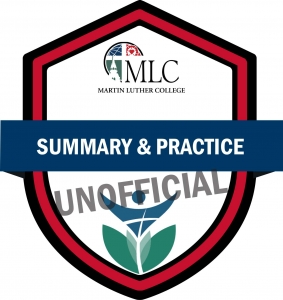MICRO-CREDENTIALS
Formal Recognition for Informal Learning
BDG0106 Summary & Practice
DESCRIPTION: Teachers who earn the Summary & Practice micro-credential create meaningful lesson closure, which includes skill reinforcement aligned to the lesson’s learning target.
EARNING THE MICRO-CREDENTIAL: To earn the Summary & Practice Micro-Credential, teachers demonstrate that they utilize lesson time to review and reinforce the main concepts and skills related to the lesson’s learning target. They know what, when, and how much extended practice is necessary for student learning, and they plan and properly scaffold it. Earners will write a brief lesson plan that includes a description of the learners (grade level, learning needs), the lesson target, any in-class scaffolding and practice activities that prepare learners for independent practice, the lesson summary, and the assignment. Earners will video-record the part of the lesson that includes the summary and practice. Finally, they will write a brief reflection that reports on their students’ practice activity performance and any insights gleaned from their teaching or students’ performance.
RESEARCH BASE: The research varies depending on what is being measured. Homework (assignments completed at home) have mixed research support. In research syntheses, Cooper (1989, 2006) found an average correlation between homework and achievement to be r = .19 (1989) and r = .24 (2006), which are weak. However, these correlations were more common in high school, with little or no correlation below grade six (Vatterott, 2009).
Providing reinforcement through purposeful practice has been found to achieve effect sizes of 0.42 (Dean, Hubbell, Pitler, & Stone, 2012) and 0.77 (Marzano, Pickering, & Pollock, 2001), which are moderate to strong. These results only occur when practice reinforces the learning target, is short, focused, and distributed over time, and includes feedback to students.
Cooper, H., Robinson, J. C., & Patall, E. A. (2006). Does homework improve academic achievement? A synthesis of research, 1983-2003. Review of Educational Research, 76(1). 1-62. Retrieved from http://upload-community.kipa.co.il/819201525856.pdf
Dean, C., Hubbell, E. R., Pitler, H., & Stone, B. (2012). Classroom Instruction that Works (2nd Ed). Alexandria VA: ASCD.
Marzano, R. J., Pickering, D. J., & Pollock, J. E. (2001). Classroom Instruction that Works (1st Ed). Alexandria VA: ASCD.
Vatterott, C. (2009). Rethinking homework: Best practices that support diverse needs. Alexandria VA: ASCD.
BACKGROUND:
The following are useful tools to better understand the topic:
Vaterott, C. (2010). Five hallmarks of good homework. Educational Leadership, 68(1). 10-15. Retrieved from http://www.ascd.org/publications/educational-leadership/sept10/vol68/num01/Five-Hallmarks-of-Good-Homework.aspx
Protheroe, N. (2009). Good homework policy. Principal (September, October). 42-45. Retrieved from https://www.teachit.so/index_htm_files/homeworkprotheroe.pdf
Carr, N. S. (2013). Increasing the effectiveness of homework for all learners in the inclusive classroom. School Community Journal, 23(1). 169-182. Retrieved from https://files.eric.ed.gov/fulltext/EJ1004337.pdf
Summary Through Assessment (video): https://www.teachingchannel.org/video/daily-lesson-assessment
MICRO-CREDENTIAL CRITERIA:
A summary & practice micro-credential earner can do the following:
- Conclude each lesson with an instructive summary.
- Scaffold students’ learning toward successful independent practice.
- Design practice exercises that match the learning target.
- Assign effective independent practice for all learners.
SKILL DEMONSTRATION:
Submit a lesson plan
Create a simple lesson plan that includes the following:
- A brief description of the learners, including grade levels, ability, and special needs.
- The lesson’s learning target.
- In-class scaffolding and practice activities.
- The plan for lesson summary.
- Description of the assignment.
Submit a lesson video
Keep in mind the following:
- Include in-class scaffolding & practice.
- Include the summary.
- Include directions for independent practice.
- Edit the video to no more than 15 minutes.
- Get permission to video-record students.
Submit a written reflection
After completing the recorded lesson, compose a written reflection (300 – 500 words) on the lesson that includes the following:
- Your reflection on how well you prepared your students for independent practice.
- A description of student performance on the independent practice.
- What you learned from the student performance.
- What you would do the same and/or differently if you taught the lesson again.
RUBRIC:
RESOURCES:
Books
Vatterott, C. (2009). Rethinking homework: Best practices that support diverse needs. Alexandria VA: ASCD. http://www.ascd.org/Publications/Books/Overview/Rethinking-Homework.aspx
Articles
Willingham, D. (2004). Practice makes perfect—but only if you practice beyond the point of perfection. American Educator. Spring Issue. http://www.aft.org/periodical/american-educator/spring-2004/ask-cognitive-scientist
Gartner, N. (2017). Are common beliefs about homework wrong? Issues in Lutheran Education. February 28. http://blogs.mlc-wels.edu/wels-educator/2017/02/28/are-common-beliefs-about-homework-wrong/
Berger, B. (2014). Elementary students do not require homework. Issues in Lutheran Education. January 15. http://blogs.mlc-wels.edu/wels-educator/2014/01/15/elementary-school-students-do-not-require-homework/
Kock, D. (2013). Homework: Purpose, value, and teacher’s role. Issues in Lutheran Education. November 15. http://blogs.mlc-wels.edu/wels-educator/2013/11/15/homework-purpose-value-and-the-teachers-role/
Marzano, R. & Pickering D. (2007). Special topic: The case for and against homework. Educational Leadership. 64 (6). pp. 74-79. http://www.ascd.org/publications/educational-leadership/mar07/vol64/num06/The-Case-For-and-Against-Homework.aspx
Videos
Efficient and Meaningful Homework Review: https://www.teachingchannel.org/videos/making-homework-meaningful
Reinforcement: https://vimeo.com/208234697
Martin Luther College Courses
EDU8532 Rethinking Homework – 1 credit (continuing education)
EDU8509 Elements of Effective Instruction – 1 credit (continuing education)
EDU5109 Designing Effective Instruction – 3 credits (graduate)




